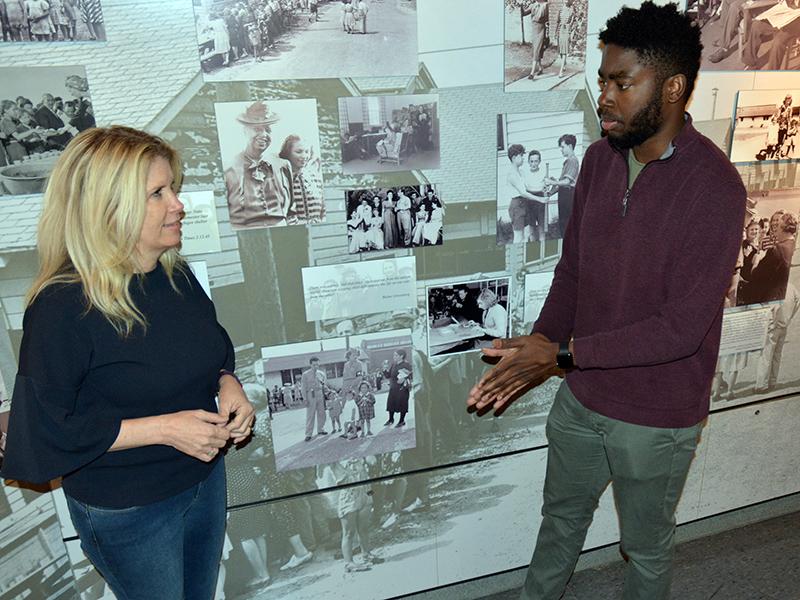Setting the scene -- Juliet Aires Giglio, an English and creative writing faculty member at SUNY Oswego, and Mic-Anthony Hay, a senior journalism major Giglio has had in class, talk at Safe Haven Holocaust Refugee Shelter Museum in Oswego about locations for filming a documentary preserving the memories of two cousins who were sheltered there. It is one of many projects recently approved for funding for Faculty-Student Challenge Grants by the college's Scholarly and Creative Activities Committee.
A SUNY Oswego faculty-student team of Juliet Aires Giglio and Mic-Anthony Hay will produce a documentary to preserve the memories of cousins who were 7 years old when they had to leave Eastern Europe for Fort Ontario's Safe Haven to escape the Holocaust.
A Faculty-Student Challenge Grant from the college's Scholarly and Creative Activities Committee (SCAC) makes the project possible, providing the means for Hay, a senior journalism major, to do cinematography and editing for the documentary this summer, and for Riki (formerly Rikicia) and David Levi -- both now 80 -- to return to Oswego for interviews from their homes in the New York metropolitan area for "A New Home in Oswego: The Story of Two Refugees."
The Levi cousins and other family members were among the 982 European, mostly Jewish, refugees who were allowed into the United States as "guests" of President Franklin D. Roosevelt from August 1944 to February 1946. The stories the Levis tell are personal for Giglio, a screenwriter and faculty member of English and creative writing at SUNY Oswego. Riki Levi is her husband's mother; David, his cousin once removed.
"For 30 years I've heard the stories my mother-in-law has told about the time at Fort Ontario," Giglio said. "If Safe Haven had not been available for the Levis, my husband (Keith Giglio) would not be here. I want to preserve Riki's and David's memories on film."
Last Thanksgiving, Giglio interviewed and videotaped Riki, who now has three children and six grandchildren, at Riki's home in Manchester, New Jersey. "I had the desire to tell the story, but I was concerned that it wasn't going to look good enough."
She then learned about SCAC Challenge Grants -- awards of up to $4,500 to promote and support student-faculty summer collaborations leading to publications or performances -- from William Bowers, the college's associate provost for research development and administration. In all, SCAC awarded more than $70,000 among 17 faculty-student projects for summer 2018.
Plans for filming
Excited to move forward, Giglio immediately thought of one of her students, Hay, a photographer with more than 56,000 Instagram followers who has been working to sharpen his cinematography skills. SCAC approved the grant application.
"It's great to have the support of the college," Giglio said. "That made this project doable."
Beside the chance to build his resume and skills, Hay said, "I've been looking for the perfect way to give back to the college. I've had great experiences here and I have so many mentors, so many people to thank. That's what also makes this such a great opportunity. I am grateful for the grant and the opportunity to work with Professor Giglio."
Riki and David visited the site of World War II's Safe Haven, the only one in the United States, in 2005 for a reunion of former refugees. But Riki has never been back to the city -- Zagreb, Croatia (formerly Yugoslavia) -- that she and her family had to flee in 1944. Giglio said Riki and she plan to return in June, where Giglio will take over the camera for documentary footage.
Giglio and Hay already have been scouting locations at Fort Ontario and the nearby Safe Haven Holocaust Refugee Shelter Museum for a week of filming, starting July 9. Paul Lear, the historic site's manager with the state Office of Parks, Recreation and Historic Preservation, and Giglio have brainstormed future uses of the documentary.
The project, Lear said, dovetails with the Safe Haven museum's goal to obtain as many accounts as possible of what happened at the emergency refugee shelter and what happened to the former refugees afterward. "With the technology available now, the possibilities are just about endless," he said.
Giglio said that in addition to submitting the short documentary to film festivals, she plans to approach public television about airing the film about the two refugee cousins.
UPDATED: See the finished documentary.
More SCAC projects
The following additional Faculty-Student Challenge Grants for summer 2018 were awarded to the listed faculty sponsor:
- "Toxic Effect of Atrazine on Fresh Water Mussels (Elliptio complanata)," Poongodi Geetha-Loganathan, biological sciences;
- "An Analysis of Period-Color Relations with OGLE IV Data," Shashi Kanbur, physics;
- "Investigation of Filamin Function in Dictyostelium Discoideum Mechanosensation," Yulia Artemenko, biological sciences;
- "Employee Benefits Challenges of Small Employers in Western New York," Michele Thornton, management and marketing;
- "Development of a Light-Responsive Controlled-Release System," Matthew Baker, chemistry;
- "Follow-up Census of Spotted Turtles (Clemmys gutatta)" in Cayuga County, Peter Rosenbaum, biological sciences;
- "Open-Source Affordable Design for DNA Delivery Device (Electroporator)," David Dunn, biological sciences;
- "Building a Centimeter-Precise Cyber-Physical Drone using Differential GPS," Bastian Tenbergen, computer science.
- "Development of the Floral 'Umbrella' of the Northern Pitcher Plant," Jinyan Guo, biological sciences;
- "Design, Synthesis and Characterization of Bimetallic Complexes Exhibiting Metallophilic Interactions," Thomas Brown, chemistry;
- "The ResLife TV pilot," Francisco Suarez, communication studies;
- "Protein Interactions That Regulate Complement Activation," Julia Koeppe, chemistry;
- "Origin and Fate of a Pyroxenite Body Within the Pioneer Mountains Core Complex, Central Idaho," Brian Hough and Rachel Lee, atmospheric and geological sciences;
- "Investigation of the Effects of Musanga cecropioides on Live Cells," Webe Kadima, chemistry;
- "Counting with S-sided Dice: Generating Combinatorics," Elizabeth Wilcox, mathematics;
- "College-School Collaboration: Responsive Interventions Designed to Empower Students," Tamara Sullivan, counseling and psychological services




